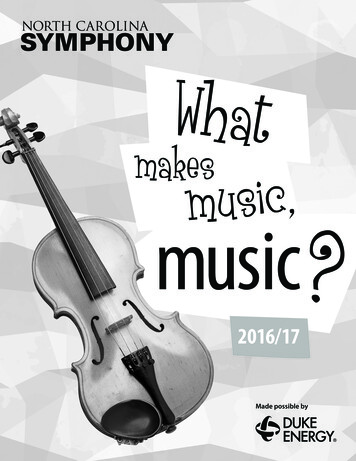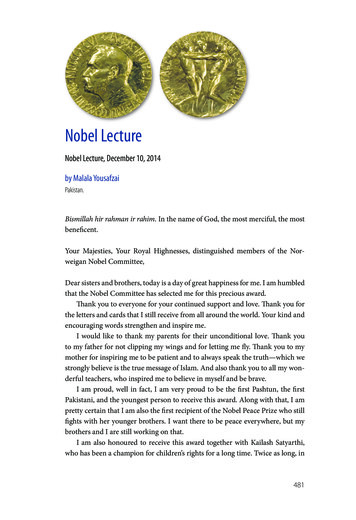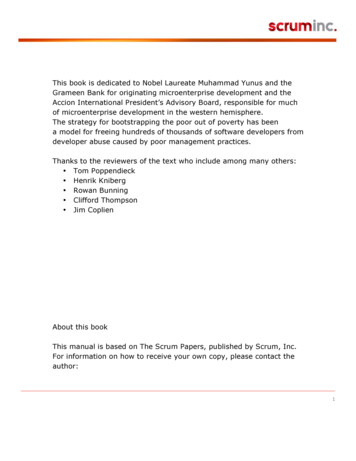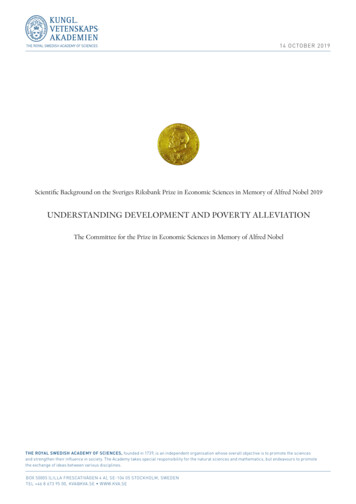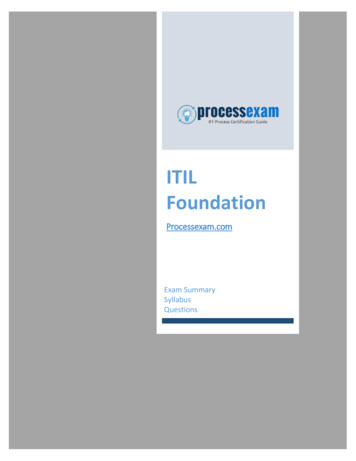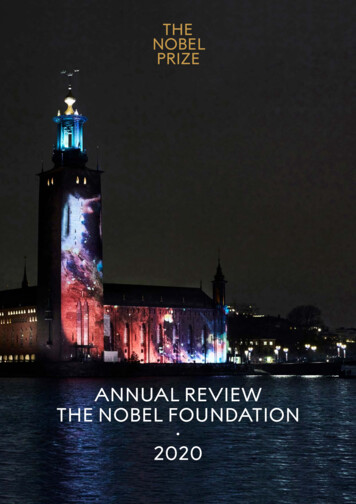
Transcription
ANNUAL REVIEWTHE NOBEL FOUNDATION 20201
Nobel Week LightsOn the façade of the Stockholm City Hall, picturesfrom the outer corners of space were shown incollaboration with Rymdstyrelsen (the SwedishNational Space Agency) and the European SpaceAgency. It was a tribute to the Nobel Prize in Physics2020, which was awarded for the discovery ofthe universe’s strangest phenomenon – black holes.The spectacular installation Space, by PXLFLD andLumination of Sweden, became one of the largestprojection mapping projects ever carried out inStockholm.PHOTO: PER KRISTIANSEN2THE NOBEL FOUNDATION · ANNUAL REVIEW 2020
IVidar Helgesen, Executive Directorof the Nobel Foundation since1 January 2021.PHOTO: CLÉMENT MORINtook over the role of ExecutiveDirector of the Nobel Foundationin January 2021, after a unique yearin the history of the Nobel Prize.It was also a year of innovation.The Nobel Week in December assumednew formats, featuring a digital celebra tion. The laureates received their medalsand diplomas in their home countries.Our public events were conducted in newways, and in some cases they reached anew and larger audience. As an organi sation, we learned a lot during 2020 lessons that we will carry with us inthe future.The fact that the Nobel Prize awardinginstitutions chose to nominate NobelPrize laureates was very well received bya world that longed for positive newswhen so much else was being cancelled.Highlighting the importance of scientificresearch and cross-border collaborationhas been an important task for us duringa year dominated by the pandemic. It is atask that will be no less important in thefuture. In the light of previous medicaladvances, we can draw attention to themonumental scientific effort thatresulted in the rapid development of newvaccines against covid-19. We can alsosee the need for a mobilisation againstrepression of science, resistance to factsand the wave of disinformation we havewitnessed during the pandemic.The Nobel Prize is a positive force insuch a mobilisation because it includesmany strong and inspiring stories abouthuman progress in difficult situations.About the importance of knowledge toTHE NOBEL FOUNDATION · ANNUAL REVIEW 2020enable decision makers to make informedchoices, about freedom of expressionand the importance of the written wordfor a free and enlightened public, andabout peaceful dialogue and conflictresolution as the basis for a free societyand human rights.The Nobel Prize’s unique combinationof subject areas gives us the opportunityto generate public engagement in theachievements that are being rewarded.We do this when the new laureates areannounced in October, when the prizesare awarded in December and everyday through our extensive public out reach activities on an international basis.In our public activities, we can addressimportant issues in which the discov eries and achievements of Nobel Prizelaureates play a role. One current exam ple is the climate change crisis. DuringApril 2021 in collaboration with theUS National Academy of Sciences andthe Potsdam Institute for Climate ImpactResearch we are organising the firstNobel Prize Summit on the themeOur Planet, Our Future. During a threeday period, several Nobel Prize laureatesand other experts, activists and decision- makers will take on the entirety of thecomplex challenges to our planet andthe solutions that the world needs toimplement quickly and on a large scale.The event was watched by a worldwidedigital audience of 25,000 people.This is just one illustration of thepower of the Nobel Prize in promotingthe greatest benefit to humankind.3
PHOTO: DAN LEPPSoloist Elisabeth Meyer performsLonely House in a deserted Blue Hallduring the Nobel Prize award ceremonytaking place in the Golden Hall upstairs.4THE NOBEL FOUNDATION · ANNUAL REVIEW 2020
Table of contents6101214161822283032343640424446485052THE NOBEL FOUNDATION · ANNUAL REVIEW 2020The 2020 Nobel Prize laureatesThe Nobel Prize in Literature 2020The Nobel Peace Prize 2020Nobel Calling StockholmA digital Nobel Peace Prize exhibitionA beacon of light in the darknessHighlights 2020Knowledge for all in new formatsDocumentary films highlight the Nobel Peace PrizeThe outdoor cinema at Sergels torgNobel lunch and Star Hunt inspire studentsall over SwedenThe Nobel Prize banquetNew design by skilful craftmanshipBottles from Alfred Nobel’s laboratories analysedThe Nobel Prize awarding institutionsThe Nobel FoundationTo engage, inspire and spread knowledgeHighlights in DecemberA focus on the climate5
PHOTO: JOY ASICOThe 2020 Nobel Prize laureatesDuring the spring of 2020, the Nobel Prize awarding institutionsdecided they would select new Nobel Prize laureates despitethe ongoing pandemic. Thanks to close collaboration withSwedish diplomatic missions abroad, all laureates were ableto receive their medals and diplomas under safe conditionsin their countries of residence.6THE NOBEL FOUNDATION · ANNUAL REVIEW 2020
PHOTO: ANNETTE BUHLWith one half toPHOTO: FERGUS KENNEDYTHE NOBEL PRIZEIN PHYSICS 2020ROGER PENROSE“for the discovery that black holeformation is a robust predictionof the general theory of relativity”and the other half jointly toRoger PenroseAndrea M. GhezPHOTO: BERNHARD LUDEWIGREINHARD GENZELANDREA M. GHEZ“for the discovery of a supermassivecompact object at the centre of ourgalaxy”Three laureates shared the Nobel Prize in Physicsfor their discoveries about one of the most exoticphenomena in the universe, the black hole. RogerPenrose showed that the general theory of relativityenables to the formation of black holes. ReinhardGenzel and Andrea M. Ghez discovered that aninvisible and extremely heavy object governsthe orbits of stars at the centre of our galaxy.A supermassive black hole is the only currentlyknown explanation.PHOTO: BRITTANY HOSEA-SMALLEMMANUELLE CHARPENTIERJENNIFER A. DOUDNAPHOTO: BERNHARD LUDEWIGTHE NOBEL PRIZEIN CHEMISTRY 2020Reinhard Genzel“for the development of a methodfor genome editing”Emmanuelle Charpentier and Jennifer A. Doudnahave discovered one of gene technology’s sharpesttools: the CRISPR/Cas9 genetic scissors. Usingthese, researchers can change the DNA of animals,plants and microorganisms with extremely highprecision. This technology has had a revolutionaryimpact on the life sciences, is contributing to newcancer therapies and may make the dream ofcuring inherited diseases come true.THE NOBEL FOUNDATION · ANNUAL REVIEW 2020Emmanuelle CharpentierJennifer A. Doudna7
PHOTO: HAN HOUGHTONHARVEY J. ALTERMICHAEL HOUGHTONCHARLES M. RICEPHOTO: FLORENCE MONTMARETHE NOBEL PRIZE INPHYSIOLOGY OR MEDICINE2020“for the discovery of Hepatitis C virus”Charles M. RiceMichael HoughtonPHOTO: JOY ASICOThis year’s Nobel Prize is awarded to three scien tists who have made a decisive contribution to thefight against blood-borne hepatitis, a major globalhealth problem that causes cirrhosis and livercancer in people around the world. Harvey J. Alter,Michael Houghton and Charles M. Rice madeseminal discoveries that led to the identificationof a novel virus, Hepatitis C virus. Prior to theirwork, the discovery of the Hepatitis A and B viruseshad been critical steps forward, but the majority ofblood-borne hepatitis cases remained unexplained.The discovery of Hepatitis C virus revealed thecause of the remaining cases of chronic hepatitisand made possible blood tests and new medicinesthat have saved millions of lives.Harvey J. AlterPHOTO: DANIEL EBERSOLETHE NOBEL PRIZEIN LITERATURE 2020LOUISE GLÜCK“for her unmistakable poetic voice thatwith austere beauty makes individualexistence universal”The American poet Louise Glück made her debutin 1968 with Firstborn, and was soon acclaimedas one of the most prominent poets in Americancontemporary literature. She has published twelvecollections of poetry and some volumes of essayson poetry. All are characterized by a strivingfor clarity.8Louise GlückTHE NOBEL FOUNDATION · ANNUAL REVIEW 2020
PHOTO: REIN SKULLERUDTHE NOBEL PEACE PRIZE 2020WORLD FOOD PROGRAMME“for its efforts to combat hunger, for itscontribution to bettering conditions forpeace in conflict-affected areas and foracting as a driving force in efforts toprevent the use of hunger as a weaponof war and conflict”World Food Programme (David Beasley, Executive Director of WFP).The World Food Programme is the world’s largesthumanitarian organisation addressing hunger andpromoting food security. In 2019, the WFP providedassistance to close to 100 million people in 88 coun tries who are victims of acute food insecurity andhunger. In 2015, eradicating hunger was adoptedas one of the UN’s Sustainable Development Goals.PHOTO: ELENA ZHUKOVAPHOTO: ELENA ZHUKOVATHE SVERIGES RIKSBANKPRIZE IN ECONOMIC SCIENCESIN MEMORY OF ALFRED NOBEL2020PAUL R. MILGROMROBERT B. WILSON”for improvements to auctiontheory and inventions of new auctionformats”Paul R. MilgromRobert B. WilsonThe two laureates, Paul R. Milgrom and Robert B.Wilson, have studied how auctions work. They havealso used their insights to design new auction for mats for goods and services that are difficult tosell in a traditional way, such as radio frequencies.Their discoveries have benefitted sellers, buyersand taxpayers around the world.THE NOBEL FOUNDATION · ANNUAL REVIEW 20209
PHOTO: DANIEL EBERSOLE10THE NOBEL FOUNDATION · ANNUAL REVIEW 2020
The Nobel Prizein Literature 2020“Louise Glück is a writer not only of contradictions andaustere reflection. She is also a poet of renewal, withfew coequals. Even if her poetry is written in retrospect,and seems bound to the apple tree as it was seen once inchildhood, one of her keywords is change. She teachesus that the moment of renewal is also the arrival of words.Her inner driving force is a spiritual hunger and an exceptional reverence for the possibilities of poetry. The leapof renewal can employ the seemingly plain diction ofthoughtful parables, but also comedy and biting wit.Extract from the speech presenting the Nobel Prize in Literatureby Professor Anders Olsson, Member of the Swedish Academy,Chairman of the Nobel Committee for Literature, 10 December 2020.THE NOBEL FOUNDATION · ANNUAL REVIEW 202011
The Nobel PeacePrize 2020“This Nobel Peace Prize is more than a thank you. It isa call to action. Because of so many wars, climate change,the widespread use of hunger as a political and militaryweapon, and a global health pandemic that makes allof that exponentially worse – 270 million people aremarching toward starvation. Failure to address theirneeds will cause a hunger pandemic which will dwarfthe impact of COVID.”David Beasley, Executive Director of the World Food Programme,in his acceptance speech on 10 December 202012THE NOBEL FOUNDATION · ANNUAL REVIEW 2020
PHOTO: WFP/KHUDR ALISSADeir Hafer in Syria is located 60 km from Aleppoand 12 km from the nearest market, so the 800people who live here rely heavily on food assistance from WFP to meet their daily needs.THE NOBEL FOUNDATION · ANNUAL REVIEW 202013
Artist Fredrik Paulsen’s colourfuloutdoor cinema on Sergels torgwas open 24 hours a day.Nobel Calling StockholmThe eyes of the world are on Stockholm and Oslo during the weekin October when the new Nobel Prizes are announced. A week whenthe importance of research, science, literature and peace are in focus.The global pandemic and thecovid-19 situation had a broadimpact on our societies in 2020.Many events were postponed or cancelledentirely. It was therefore gratifying thatlast spring the Nobel Prize awardinginstitutions decided to carry out theinvestigative work that would enablethem to announce new Nobel Prizelaureates in October. This was a yearwhen it was especially important tohighlight scientific, literary and human itarian efforts that provided inspirationand hope for the future.The public programme points known asNobel Calling Stockholm were also car ried out during the weeklong announce ment period, but with a limited audience.14For the first time, they were also livestreamed so they could be viewed online.At Kulturhuset, Stockholm’s municipalcultural centre, members of the NobelCommittees that selected the laureatesgave a Crash Course on the year’s threescience prizes. In a broadcast from theStockholm Public Library, you couldlisten to an in-depth conversation aboutthe year’s literature laureate with mem bers of the Nobel Committee. The week’sprogramme also included a series ofseminars related to covid-19, the NobelPrize Teacher Summit Migration andMovements and a peace panel featuringamong others Beatrice Fihn, ExecutiveDirector of the International Campaignto Abolish Nuclear Weapons (ICAN),which received the 2017 Nobel PeacePrize. The whole week was framed by acolourful outdoor cinema on Sergels torg,a square in central Stockholm, which wasopen 24 hours a day.The events during Nobel Calling Stock holm 2020 were organised by the NobelPrize Museum in collaboration with theCity of Stockholm, Karolinska Institutet(a medical university), the Royal Instituteof Technology, Stockholm University,Stockholm Public Library, KulturhusetStadsteatern, Forum/Debatt, StockholmCity Hall, Stockholm City Archives,the Swedish Research Council and theRiksbank. The events were presentedboth physically and digitally.THE NOBEL FOUNDATION · ANNUAL REVIEW 2020
ALL PHOTOS: CLÉMENT MORINOne school class participated dailyin the announcements which wasbroadcast live at the museum.Carin Klaesson, Henrik Petersen, MikaelaBlomqvist, Rebecka Kärde and Anders Olssondiscussed the 2020 Nobel Prize in Literatureat the Stockholm Public Library.THE NOBEL FOUNDATION · ANNUAL REVIEW 202015
PHOTO: AÏDA MULUNEH FÖR NOBELS FREDSCENTEROne of the conflictsillustrated in the 2020Nobel Peace Prizeexhibition is in Syria,where controlling foodand emergency aidhas been an importantwar strategy for theregime during theongoing civil war.16THE NOBEL FOUNDATION · ANNUAL REVIEW 2020
PHOTO: JOHANNES GRANSETH / NOBELS FREDSSENTERAs soon as a new Nobel Peace Prizelaureate is announced, the Nobel PeaceCenter updates the area of its permanentexhibition known as the Nobel Field.A digital Nobel PeacePrize exhibitionFor the first time ever, the Nobel Peace Center’sexhibition about the year’s Nobel Peace Prizeappeared in a digital version that could be viewedworldwide.The 2020 Nobel Peace Prizeexhi bition could be seen by every one, even though the museumin Oslo was closed due to the pandemic.For the first time, the Nobel PeaceCenter collaborated with the NorwegianBroadcasting Corporation (NRK) onthe photo exhi bition about the year’slaureate. The exhibition was publishedonline on 10 December, the same day thatthe World Food Programme (WFP) wasawarded the Nobel Peace Prize. By theend of the year, the exhibition had beenviewed by more than 18,000 people.“In a year where the pandemic makesphysical exhibition visits difficult, we arehappy to be able to reach a large audiencewith our Peace Prize exhibition throughNRK,” says Kjersti Fløgstad, ExecutiveDirector of the Nobel Peace Center.The 2020 Nobel Peace Prize exhibitionpresents a photo essay by renownedEthiopian photographic artist AïdaMuluneh. In ten powerful images, sheillustrates different conflicts in whichfood was used as a weapon of war –a weapon that primarily affects the civil ian population. “Each frame is a story,a story deeply embedded with moments,emotions, pain, loneliness, rage and thedeep sadness that becomes the plightof those caught between the crossfiresof political agendas,” Muluneh says.On 11 December the Nobel PeaceCenter organised an online conversationwith both photographer Aïda Mulunehand David Beasley, Executive Director ofWFP. “Aïda’s photos bring to life a realitythat we see out there every day”, Beasleysaid during the conversation.Due to covid-19 the Nobel PeaceCenter has been closed since November2020, but a physical version of the NobelPeace Prize exhibition will be in place forpublic viewing when the center reopens.17
PHOTO: EMMA HJORTENKLEV WASSBERG/FREDRIK MATZAfter almost a year of social distancing,many people were touched by the lightinstallation on the fifth Hötorget skyscraper in Stockholm’s central businessdistrict: the projection I want to hold youin my arms but can’t by Emma HjortenklevWassberg and Fredrik Matz.18THE NOBEL FOUNDATION · ANNUAL REVIEW 2020
A beacon of light in the darknessWith light installations illuminating many iconic locations andbuildings, Nobel Week Lights invited Stockholm residents to celebratethe week. This completely new cultural experience provided a beaconof light in the darkness when we needed it most.Inspired by international festivalssuch as the world-famous Fête desLumières in Lyon, France, NobelWeek Lights illuminated about fifteenplaces in Stockholm with light installa tions. Many of the participating artistsand light designers explored new ideasand enabled us to reimagine how weexperience our urban environment.They wove together art and technologyin playful ways. Some of their workswere inspired by the discoveries andachievements of Nobel Prize laureatesfor the greatest benefit to humankind.During a year when many of the NobelWeek activities were entirely digital,this was a cultural experience that couldbe enjoyed outdoors at a safe distancefrom others.According to the City of Stockholm, thelight installations were visited by morethan 200,000 people. A digital tour ofthe Nobel Week Lights was also availableduring 5–13 December. The StockholmCity Hall, Sergels torg, Konsert husetStockholm, the Royal Dramatic Theatre,Stockholm City Museum and Nobel PrizeMuseum were among the buildings andplaces that served as settings for thesespectacular and artistic light installations.Nobel Week Lights was initiated andproduced by Annika Levin, AlexandraManson, Lara Szabo Greisman andHelmet Experience Design in collabo ration with the Nobel Prize Museumand the City of Stockholm.PHOTO: PER KRISTIANSENMore than 1,300 visitors uploaded their own photos and videoson Instagram, using the hashtag #nobelweeklights. The NobelWeek Lights campaign reached more than a million people onsocial media.THE NOBEL FOUNDATION · ANNUAL REVIEW 202019
PHOTO: PER KRISTIANSEN20THE NOBEL FOUNDATION · ANNUAL REVIEW 2020
Sense Light Swing, by Alexander Lervik, was animpressive light artwork that visitors themselveshelped to create as they swung back and forthin the darkness, both in Kungsträdgården parkand in Skärholmens centrum.21
PHOTO: CLÉMENT MORIN962Nobel LaureatesSince 1901, the Nobel Prize and theSveriges Riksbank Prize in EconomicSciences in Memory of Alfred Nobelhave been awarded to 962 individualsand organisations. Laureates: 962Prize categories: 6Prize-awarded women: 57Prize-awarded organisations: 25Youngest laureate: 17 yearsOldest laureate: 97 years”This year it was especially important toselect Nobel Prize laureates and to awardprizes. During the past decade, we have seenincreased scepticism, if not disdain, towardsscience. Meanwhile the ongoing pandemichas made it obvious how vital knowledgeand science are.”Lars Heikensten, Executive Director of the Nobel Foundation from 2011 to 2020,on the importance of awarding Nobel Prizes during 2020 despite the pandemic. 22Nobelprize.org had 19.6 millionvisitors during 2020, up by 12%compared to 2019.The number of Instagram followersrose by 191% during 2020.The number of YouTube followersclimbed by 103% during 2020.In 2020, Nobel Prize digital channelssurpassed 6.5 million followers.During the prize announcementperiod in October, the Facebookaccount reached 8.6 million peopleper day, an increase of 54% fromthe previous year.The Nobel Week programmes inStockholm and Oslo were madedigitally available and reached adaily average of more than 900,000viewers on Facebook and 1.3 millionon Twitter. NOBEL COMMITTEE FOR PHYSIOLOGY OR MEDICINE. ILL. MATTIAS KARLÉNThe Nobel Prizewebsite andsocial mediachannelsPart of the Nobel Prize Lesson on the 2020 Prizein Physiology or Medicine.Nobel Prize Lessons within 24 hoursEvery October we learn whatdiscoveries and achievementshave been rewarded by the year’sNobel Prizes. A day after eachannouncement, a complete package of lesson materials on eachrespective prize can be downloaded from nobelprize.org byteachers all over the world. Thereare also Nobel Prize Lessons onsuch themes as Alfred Nobel,human rights and sustainabledevelopment. Read more aboutNobel Prize Lessons and thebroad school and educationalactivi ties for students and teachers offered by Nobel PrizeMuseum on page 34.THE NOBEL FOUNDATION · ANNUAL REVIEW 2020
PHOTO: CLÉMENT MORINNadia Murad’svisit to StockholmThe Nobel Peace Prize laureate NadiaMurad visited Nobel Prize Museumin February 2020 and signed a chairin the museum’s Bistro, like manylaureates before her. Murad wasawarded the 2018 Nobel Peace Prizetogether with Denis Mukwege for theirefforts to end the use of sexual violenceas a weapon in armed conflicts.PHOTO: DAN LEPPTwo new podcast series aboutthe Nobel PrizeThe Golden HallThe bust of Alfred Nobel which we are used toseeing on stage in the Concert Hall appearedinstead in the Golden Hall at Stockholm City Hall,where the Nobel Prize award ceremony tookplace. Floral decorations by Per Benjamin.THE NOBEL FOUNDATION · ANNUAL REVIEW 2020During 2020 two new podcast series were launched.In Nobel Prize Conversations, listeners can acquaint themselves with some of the people who have received theNobel Prize over the years. The host of these conversationsis Adam Smith, who also conducts one of the first interviewswith the laureates for the official Nobel Prize media channelsevery October. The conversations in the podcast seriescentre on motivation, ceativity and life choices – both largeand small – that have influenced the lives of the laureates.In the Swedish-language podcast series Idéer som för änd rar världen (Ideas Changing the World), Nobel Prizeexpert Gustav Källstrand engages with researchers, writersand other experts to discuss ideas related to science, literatureand peace. Together they explore the ideas that have beenso outstanding that they were awarded with a Nobel Prize.23
PHOTO: ISAK DE JONGPHOTO: DAN LEPPNobel CreationsSince 2011 students in the fashionprogramme at Beckmans College ofDesign in Stockholm have created freeinterpretations of the Nobel Prizes.Based on black holes, gene splicing,auction theory, the hepatitis C virus,poetry of Louise Glück, as well as theWorld Food Programme’s effortsto eradicate hunger during 2020the students created six strong fashiondesigns that have been on displayat the Nobel Prize Museum.PHOTO: JOHANNES GRANSETH/NOBEL PEACE CENTERBlack holes as fashionNew web shop at theNobel Peace CenterWhen the Nobel Peace Center in Osloclosed last spring due to the pandemic,it began working to make the fineproducts in its shop available online.The Nobel Peace Shop was developed, and people can now buy thePeace Center’s sustainable productsonline – for example these animalsmade by Edgar in Zimbabwe. He provides work for his family and friendsby hammering out animals fromrecycled car parts. When a bunchof animals are ready, he puts them inbig bags and travels to South Africaby bus, hitchhiking or walking. In SouthAfrica, he then sells them to the PeaceCenter’s contact person.24“A vanishingly elegant mystique emanating fromspinning black holes pulls entire galaxies into theirdarkness, where time and space are distortedand become one, and where the rigid meets theelusively fleeting.”Amanda Stuve and Joel Eriksson on their creationinspired by the Nobel Prize in Physics.Message of joyJennifer A. Doudna’s reaction after the announcementof the 2020 Nobel Prize in Chemistry was a much-appreciatedpost that reached over 1.2 million people on Facebook andover 1.3 million people on Twitter.THE NOBEL FOUNDATION · ANNUAL REVIEW 2020
PHOTO: HELÉNE GRYNFARBSlussen the new site ofthe future Nobel CenterThe Nobel Prize shows that ideas canchange the world. In an era when facts,science and fundamental human valuesare being questioned, a place for ideas,knowledge and reflection is needed.In February 2020, the Nobel Foundation and the City of Stockholm announced that Slussen will be the site of a newhouse for culture and science, whichwill offer broad public activities including exhibitions, school programmes,lectures and conversations about themajor issues of the future. The NobelCenter will be one of Stockholm’s mostaccessible destinations. It will occupya fantastic location on the Stadsgårdskajen waterfront next to the Slussentraffic hub in the heart of Stockholm.PHOTO: NIAIDMini-exhibition on virusesWe are in the midst of a pandemic that is impacting people and societies in ways that are hardto grasp. The mini-exhibition Contagious aboutNobel Prize awarded research that has expandedour knowledge about viruses, mapped ourimmune system and developed vaccines can beviewed at nobelprizemuseum.se/en/whats-on/contagious.Museums join forces to establish a new storage facilityPHOTO: REBECKA OXELSTRÖMDuring the autumn of 2020, an initiative was takenfor a new materials storage facility where museums,art galleries and theatres in Stockholm could jointlytake advantage of and reuse materials from exhibition productions, stage sets and decor.“This is a fantastic new collaborative effort thatbrings those of us who work in the cultural sectorcloser together and reduces the resource con sumption from our productions. It is both smartand sustainable to avoid having to throw awaymaterials from previous exhibitions and to be ableto reuse things that others have brought in,” saidErika Lanner, Director of the Nobel Prize Museum,at the inauguration of the facility.In addition to the initiator Liljevalchs Gallery,the participants are the Royal Dramatic Theatre,Kulturhuset Stads teatern, the Royal Opera,the Museum of Performing Arts, Nobel PrizeMuseum, the Nordic Museum and StockholmCity Museum.THE NOBEL FOUNDATION · ANNUAL REVIEW 202025
Both during Nobel Calling Stockholm,in conjuction to the announcementsduring the fall, and during the NobelWeek in December, photos of iconicNobel Prizes appeared on digitalscreens around Stockholm City.26THE NOBEL FOUNDATION · ANNUAL REVIEW 2020
PHOTO: CLÉMENT MORINTHE NOBEL FOUNDATION · ANNUAL REVIEW 202027
Knowledge for allin new formatsThe pandemic put a stop to large physical meetingsand long-distance travel, but at the same timeit speeded up the development of entirely new,creative ways of thinking about how we can spreadknowledge and inspire people around the world.The year was soon filled with stimu lating hybrid meetings, digitalevents and new forms of meetingsbetween Nobel Prize laureates, students,scientists and the business community.These activities reached millions ofpeople and provided many lessonsalong the way.The pandemic generated new waysof spreading knowledge and ofinspiring people globally. Cellist andstudent conductor Tsepo KolitsoePooe talking to Laura Sprechmann,CEO of Nobel Prize Outreach, aboutmusic and education.The studio production during NobelWeek Dialogue enabled interactionbetween the speakers, who all participated from their home countries.Carin Klaesson, curator at NobelPrize Outreach, in a conversationabout education for all and thechallenges of learning.28“What we have learnt is that we canearn at home but not all the time.Science is about learning from experienceand collaboration. In the end we needto be together,” said chemistry laureateFrances Arnold during the 2020 NobelWeek Dialogue. She was one of eightlaureates who participated, together withsuch speakers as Akinwumi Adesina,president of the African DevelopmentBank Group and Mary Robinson, formerpresident of Ireland. The theme of theyear’s conference was The Challengeof Learning.Many of the conversations at the NobelWeek Dialogue dealt with how the pan demic has affected and will continue toaffect educational systems around theworld. Lessons, pitfalls and good exam ples from our new digital world werehighlighted.Another issue discussed was thechallenges we face when many studentslack the technical equipment for digitalinstruction. For the first time, the NobelWeek Dialogue was produced withoutan audience physically on site. Instead,a global digital audience was reachedby a studio production and an event plat form that made interaction with thespeakers possible. As a result of thisdigital approach, the conversationsremain available on the Nobel Prizedigital platforms, and the discussionswill continue to engage and inspire moreviewers. As part of the Dialogue, uppersecondary students in Gothenburg,Sweden, also had the opportunity to askquestions in a digital conversation withNobel Prize laureate Ben Feringa.As part of the Nobel Prize InspirationInitiative programme, another digital con versation took place. Aaron Ciechanover,Nobel Prize laureate in chemistry, 2004,shared ideas with a Polish audience con sisting of students, early-career scientistsand the general public. During the con versation, the students were able to askquestions and were also invited to a digi tal round table discussion – an effectiveway for both laureates and students tointeract with each other. The discussionswere about what role science can play insolving future challenges in society, andhow scientists can help individuals makethe best choices considering the over whelming quantity of information anddisinformation that people face.“If you do not know the pitfalls you’lljust do it!” This is one bit of advice for thestudents who took part in a digital con versation with laureate Stefan Hell. Theconversation was a foretaste of the NobelPrize Dialogue Korea, which will be heldin hybrid format during 2021. ProfessorHell described what it is like to be a scien tist and told about the journey he hadmade that led to his being awarded the2014 Nobel Prize in Chemistry. The inter viewer in this “pre-event” was AdamSmith, chief scientific officer of NobelPrize Outreach. Jung-Hye Roe, presi
THE NOBEL FOUNDATION · ANNUAL REVIEW 2020 3 Vidar Helgesen, Executive Director . 12 The Nobel Peace Prize 2020 14 Nobel Calling Stockholm . Her inner driving force is a spiritual hunger and an excep-t


